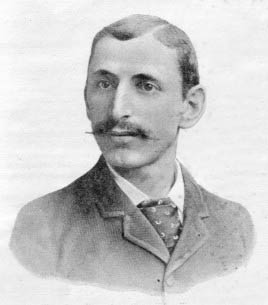
Edward Winter

Remarkably, the forename of S. Lipschütz (1863-1905) is still a mystery. As Jeremy Gaige writes on page 41 of his A Catalog of U.S.A. Chess Personalia (Worcester, 1980):
‘His first name has been variously given as Samuel, Simon or Solomon. The weight of evidence does not clearly favor any of them. The reader might care to note the following from the American Chess Bulletin, 1906, page 31: “We are indebted to Mr T.J. Johnston of New York, an intimate acquaintance of the dead master, for calling attention to the fact that the latter’s name was Solomon ... and not Simon, as stated.”’
(555)
As documented in Jeremy Gaige’s Chess Personalia, writers have put Simon, Solomon and Samuel. Gaige himself chose ‘S[ámuel?]’ and gave his date of death as 30 November 1905 (in Hamburg, at the age of 42). The December 1905 American Chess Bulletin (page 357) reported that Lipschütz’s ‘health had for a long time been unsatisfactory, owing to weakness of the lungs’.
We wonder if a reader in the Hamburg area could check local records for further information.
(3172)
We are grateful to HarpWeek LLC for permission to reproduce a group photograph which appeared in Harper’s Weekly at the time of the New York, 1893 tournament:
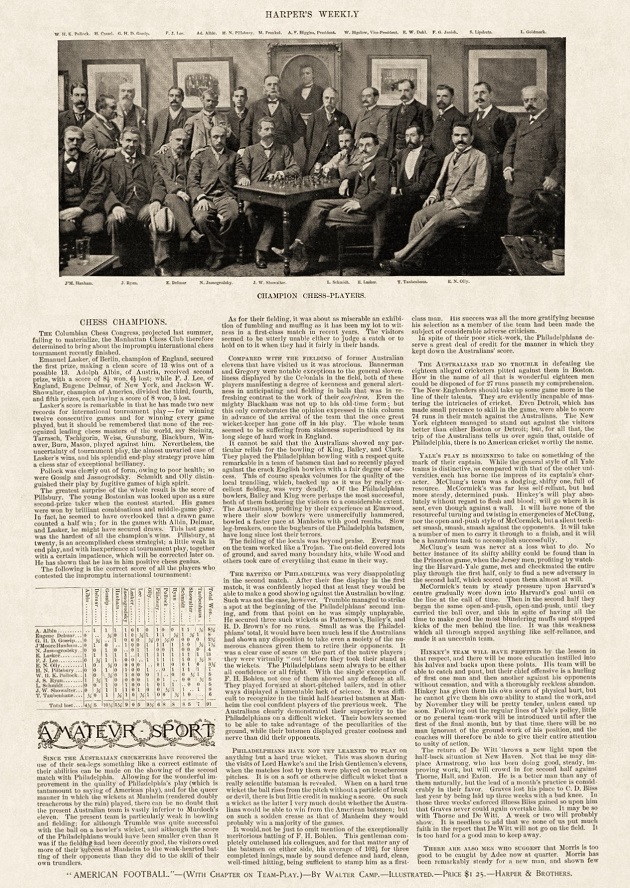
From left to right in the back row: W.H.K. Pollock, H. Cassel, G.H.D. Gossip, F.J. Lee, A. Albin, H.N. Pillsbury, M. Frankel, A.F. Higgins, W.Bigelow, E.W. Dahl, F.G. Janish, S. Lipschütz and L. Goldmark.
Front row: J.M. Hanham, J. Ryan, E. Delmar, N. Jasnogrodsky, J.W. Showalter, L. Schmidt, Em. Lasker, J. Taubenhaus and E.N. Olly.
(3240)
With regard to the mystery concerning Lipschütz’s first name, Anders Thulin (Malmö, Sweden) has checked the website www.ancestry.com, which includes computerized lists of passengers to New York. He reports:
‘Lipschütz participated in the London, 1886 tournament, which ended on 29 July. The passenger lists should consequently feature a Lipschütz, arriving in New York in August or possibly September that year. They show that a Mr S. Lipschutz, aged 25, arrived in New York on 18 August 1886 on the ship Wisconsin from Liverpool.
This is presumably our Lipschütz, even though he seems slightly older than expected; he should be 22-23 years of age if he was born in 1863. But unfortunately there is only the initial S., and not a full name. No occupation, just “gent”.
According to the biographical feature in the Chess Monthly (December 1891, page 98), Lipschütz emigrated to the US when aged about 17½; this means around 1880, assuming that he was indeed born in 1863. Thus, another list entry should exist from that time.
There is a record stating that Salom. Lipschutz, 19 years old, born in Hungary, arrived in New York on 4 September 1880 on the ship Cimbria from Hamburg and Le Havre. Again, he is slightly older than expected, but seems to be the same age as the Lipschütz from 1886.
A check for other Lipschützes – particularly anyone named Simon or Samuel – produces nothing quite as good for these dates. (One “Samuel Lipschütz”, born around 1861, a turner, arrived on 12 August 1891, on the ship State of Nebraska, apparently via Glasgow from Russia. A “Simon Lipschütz”, a worker, from Galicia, aged 28, arrived on 8 January 1884, from Hamburg.)
On the assumption that S. Lipschütz did enter the United States of America through New York (almost certain), and was aged 19 in September 1880 (or had reasons for claiming so at the time), and that the records are complete, it seems likely that his first name was “Salomon”, possibly “Solomon” or a near equivalent.
The difference in age between S. Lipschütz in the Chess Monthly article and the Lipschutz who appears on the passenger lists is irritating, however.’
(3520)
A further piece of contradictory evidence about S. Lipschütz’s forename comes on page 2 of the monograph about him brought out by the Chess Player in 2000. It gives the following translation from page 108 of the Hungarian publication Kárpáti Kalendárium, 1980:
‘We’ve learned just lately from the register of births that Samuel, the son of Mr Lipschütz, a tradesman living in poor circumstances, and their fifth child, was born in 1863 [4 July]. Little Samuel’s chess talent attracted attention in his early childhood, but the hard struggle to earn a living prevented him from improving his play. He became a printer’s apprentice at the age of 14 and made every effort to become a pressman. However, after a little while he left the printer’s shop and emigrated to the UK and later to the USA.’
The Chess Player monograph is entitled Samuel Lipschütz.
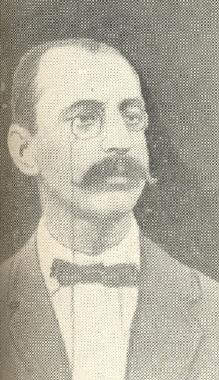
S. Lipschütz
(4804)
John Blackstone (Las Vegas, NV, USA) sends the obituary of S. Lipschütz in the New York Times, 5 December 1905, page 9:
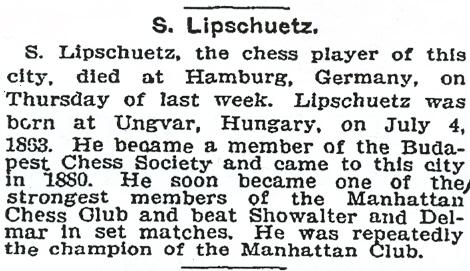
Our correspondent notes, in particular, that 1880 is given as the
year of the master’s arrival in New York.
(5302)
Mr Blackstone provides this item from page 3 of the Brooklyn Daily Eagle, 10 June 1915:
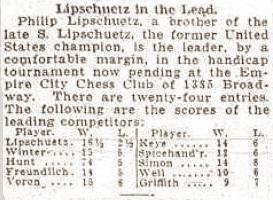
Page 157 of the July-August 1915 American Chess Bulletin reported that the event, the second handicap tournament of the Empire City Chess Club, had recently been won by ‘Philip Lipschuetz, brother of the former United States champion’.
(6657)
Eduardo Bauzá Mercére (New York, NY, USA) forwards us page 462 of the fourth issue of Club Men of New York, 1901-02 (New York, 1901):

The publication announced its scope as follows:
‘Full membership of the leading clubs, societies, college alumni associations, &C, of Greater New York * Occupations, business and home addresses * Historical sketches of all prominent New York organizations * Principal clubs, with addresses, in the 100 largest cities of the United States.’
Our correspondent also quotes from pages 3-4:
‘Every effort has been made in this issue, however, to secure accuracy, even at the expense of delaying publication nearly 60 days. While the various official lists of members, courteously furnished (often with addresses) by the officers of almost every club, have been the first and principal authority for the information herein contained, a personal letter of enquiry with return information blank was sent to each person whose name appears in this work. In addition, a great number of supplemental inquiries were sent out. Thousands of replies have been received, adding greatly to the accuracy and value of the work.’
C.N. 3172 noted that Lipschütz died in Hamburg, and we are still hopeful that a reader in that area will be able to check the local records for references to the master’s forename.
(6688)
Stephen Davies (Kallista, Australia) has been investigating further the question of S. Lipschütz’s forename, and he summarizes his findings as follows:
‘1. Lipschütz’s US naturalization card
Forename: Salomon
Birth: 4 July 1863
Date of arrival in the United States: 4 September 1880
Witnessed by Nathan Lipschütz, his father.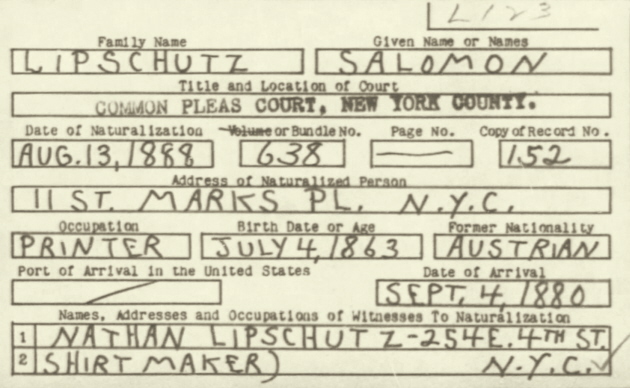
Source: ancestry.com
2. Passenger manifests of the SS Cimbria on departure from Hamburg (22 August 1880) and arrival at New York (4 September 1880)
Forename: Salom
Year of birth: 1861
The arrival manifest is that quoted by Anders Thulin in C.N. 3520. The date of arrival suggests that this is indeed S. Lipschütz the chessplayer, but whether “1861” was derived from an official document, a deliberate falsification or a mistake will probably never be known.
It is odd that his return from London in 1886 should also give an implied birth-year of 1861. Passports were not required in those days; Pillsbury applied for one (C.N. 6267), but I have not found an application by any other American chess figure of that era.3. 1900 Census
Forename: Samuel
Birth: August 1863
US arrival: 1881
He was living with his younger brother Frederick and the latter’s wife Malvina (or Malvine) at 154 Lenox Avenue (now Malcolm X Avenue), Manhattan.A possible explanation for the incorrect dates of birth and arrival in the United States is that he was not at home when the census-taker called and that the information was supplied by Malvina; she was unsure of the dates but knew him as Samuel.
As regards Philip Lipschütz, I have not yet found his dates of birth and death.
A person named Lipschütz but not Samuel (who was then in California) finished equal second in the general tournament of the 17th annual winter championship of the New York State Chess Association (NYSCA) on 22 February 1895 (New York Times, 23 February 1895, page 6.) The following month “F. Lipschutz” played for the Metropolitan Chess Club against the Manhattan Chess Club, an event which the New York Times (18 March 1895, page 6) stated was his début in public play.
An initial printed in a newspaper is unreliable. Whether either Philip or Frederick played in both events, or they each played in one, is unknown.
The pinnacle of Philip’s career may have been his equal first place in class A of the general tourney of the NYSCA winter championship of 1910 (American Chess Bulletin, March 1910, pages 61-62). However, the periodical gave him the initial “T.”.
The games attributed to “S. Lipschuetz” for the Rice Chess Club against Black and Selover of the Brooklyn Chess Club in February 1909 (American Chess Bulletin, March 1909, pages 60-61; April 1909, page 88; May 1909, page 113) were almost certainly played by Philip, given that the December 1909 issue of the Bulletin (page 276) listed him as an entrant in the Rice Chess Club’s annual handicap tournament. Salomon/Samuel had died in 1905.’
(6752)
We are grateful to Jerry Spinrad (Nashville, TN, USA) for a list of 17 references to either F. or P. Lipschütz in US newspapers between 1892 and 1945 (although mainly in the 1890s).
(6817)
From Larry Crawford (Milford, CT, USA):
‘G.H. Mackenzie was considered the US champion “by acclaim”, as was Morphy before him. Mackenzie won the second (Cleveland, 1871), third (Chicago, 1874), and fifth (New York, 1880) American Chess Congresses but was too ill to play in the sixth Congress (New York, 1889). S. Lipschütz was the US player who finished highest behind the five foreign masters at New York. On the assumption that Mackenzie had retired owing to poor health, a claim was made to consider Lipschütz the new US champion. In February 1890 Showalter finished ahead of Lipschütz at the third Congress of the US Chess Association, held in St Louis. Soltis and McCormick wrote on page 29 of the second edition of The United States Chess Championship, 1845-1996 (Jefferson, 1997):
“The gentleman farmer from Minerva, Kentucky [Showalter], then [after St Louis] crowned his success in a short match with Lipschütz and it was on the basis of this that he would later say he was US champion.”
The book gave one game played between Showalter and Lipschütz (“Match, Louisville 1890”).
There are hints here and there about an 1890 Showalter-Lipschütz match:
- “About this time he [Showalter] won nine straight games of Lipschütz (including the two games in the St Louis Tourney), at Cincinnati, Georgetown [KY], Lexington and Indianapolis, winning a purse of $50 offered by the Indianapolis Club.” (Frank Leslie’s Popular Monthly, August 1894, page 249).
- “Beaten by Showalter at St Louis and Indianapolis, he [Lipschütz] subsequently defeated him [Showalter] in a match in New York by seven to one and seven draws.” (Frank Leslie’s Popular Monthly, September 1894, page 250).
- “Played at Indianapolis, in an unfinished match between Messrs. J.W. Showalter of Georgetown, Ky and S. Lipschütz of New York, the first and third prize-winners in the recent US Association Tourney.” (BCM, May 1890, page 208). In the BCM one game was given (not the same game as in Soltis and McCormick’s book).
- “Wie verlautet, werden die Herren Showalter und Lipschütz einen Match mit Einsatz von 300$ in Louisville demnächst spielen. (Louisville ist unterdessen durch einen Orkan verwüstet worden. D. Red.)” (Deutsche Schachzeitung, April 1890, page 127). That tornado hit Louisville on March and is unlikely to be relevant to the issue at hand, unless the match was to be held after Lipschütz finished his match with Delmar.
- “Showalter and Lipschütz will go together to Louisville to play a match of seven games for a prize.” (New York Sun, 12 February 1890, page 4).
I found it easier to track Lipschütz’s movements in the New York Sun during early 1890 than those of Showalter. Lipschütz was back in the city in time to play in the State tournament on 22 February. He also had an ongoing match with Eugene Delmar. They played two games in January prior to Lipschütz leaving for St Louis, and they resumed the match on 4 March. They customarily played games on Tuesdays and Saturdays, but with adjournments there were some variations in that schedule. I see games listed on 4, 8, 11, 18 and 29 March and 5, 12, and 19 April, with games seven and eight probably played on 22 and 25 March respectively.
Showalter’s match with Judd began on 19 May 1890. Contemporary newspapers called it a championship match. Here are a few examples:
- “The first game in the match between Max Judd and J.W. Showalter at St Louis for the championship of the United States was played on Monday night.” (New York Sun, 23 May 1890, page 4).
- “Max Judd, of St Louis, and James [sic] Showalter, of Kentucky, opened their series of chess contests at the rooms of the chess club in St Louis last night for the American championship and a purse of $500.” (Brooklyn Daily Eagle, 19 May 1890, page 4).
- “... the chess contest between O. [sic] W. Showalter, the champion of the United States, and Max Judd of St Louis for $250 and the championship ...” (New York Evening Post, 21 May 1890, page 5).
It seems that a Showalter-Lipschütz match would be the basis for Showalter’s original claim to the US championship title, and for such a match to occur after the St Louis tournament and before the Judd match it would need to have taken place between 11 and 22 February 1890 or possibly between 19 April and 19 May 1890.
Further clouding the waters, in a column at the Chess Café Hanon Russell quoted extensively from a letter by Walter Penn Shipley published in Lasker’s Chess Magazine, November 1904 (see pages 13-15):
“After the death of Captain Mackenzie, S. Lipschütz, who had won a number of matches and tournaments, was recognized both in the East and in the West as the American champion. That title was given to him by all the clubs and in the various chess columns published throughout this country and many of those abroad. I never heard the same in any way disputed. In 1891, Showalter challenged Lipschütz for a match for the American championship and a stake of $750 a side.”
When Max Judd was planning the 1904 St Louis American Chess Congress he wanted to call the winner “US champion”. Judd’s position was that while Pillsbury was the strongest player of his day, he never played anyone who held the title of US champion and therefore did not hold the title himself. Pillsbury objected, and both he and Judd appealed to Shipley as an arbiter. Shipley detailed the lineage of the US championship to show that Showalter was, in fact, US champion when Pillsbury defeated him in 1897. The first Showalter v Lipschütz match which Shipley mentioned is the one which Lipschütz won in 1892 (the challenge was issued in 1891, but the match was played in 1892). Shipley was well informed on US chess, knew many top players, and served as the stakeholder for the 1896 Showalter v Kemény match. Was Shipley’s omission of an 1890 Showalter v Lipschütz match an indication that no match took place or that a match began but was not completed?’
(6996)
Addition on 7 May 2011: Larry Crawford notes that on page 19 of the 15 November 1883 issue of the Brooklyn Chess Chronicle the list of participants in the Sixth Annual Handicap Tournament of the Manhattan Chess Club included ‘Salomon Lipschutz’.
Pages 102-104 of the July 1892 American Chess Monthly:
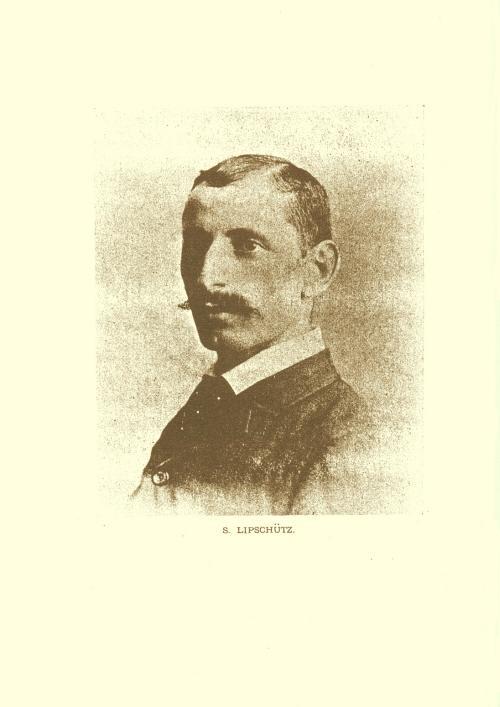

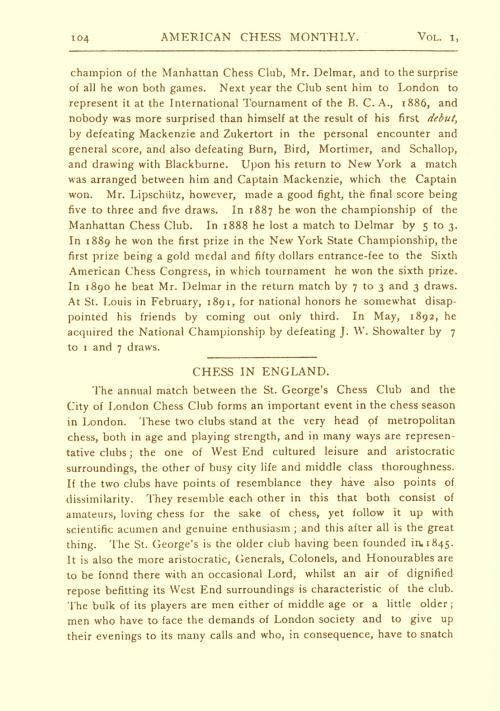
A reference to ‘Simon Lipschuetz’ on page 3 of the January-February 1938 American Chess Bulletin:
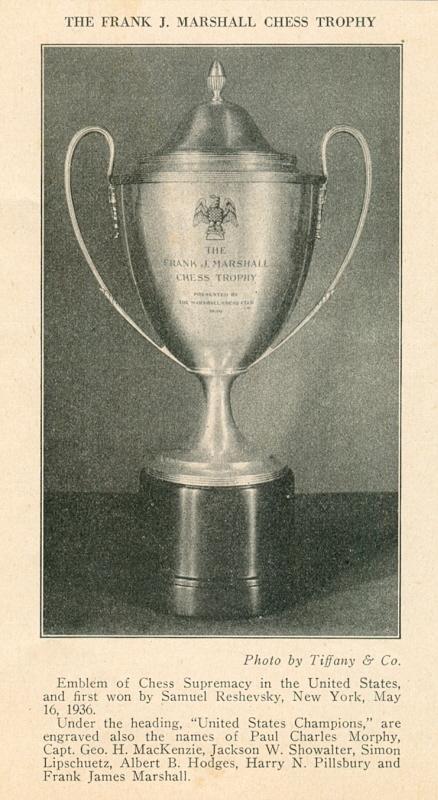
From page 208 of the July-August 1906 Wiener Schachzeitung:
‘S. Lipschütz, der bekannte amerikanische Schachmeister, ist Ende November 1905 im Hamburger Krankenhause im Alter von 42 Jahren gestorben. Seine Leiche wurde im Hamburger Krematorium verbrannt.’
Is it really impossible to find anything about Lipschütz (and, in particular, his forename) in archives or other reference sources in Hamburg?
(7652)
From Stephen Davies (Kallista, Australia) comes the registration of Lipschütz’s death, which has been found for him by Mr Ralf Stullich of the website beyond-history.com:
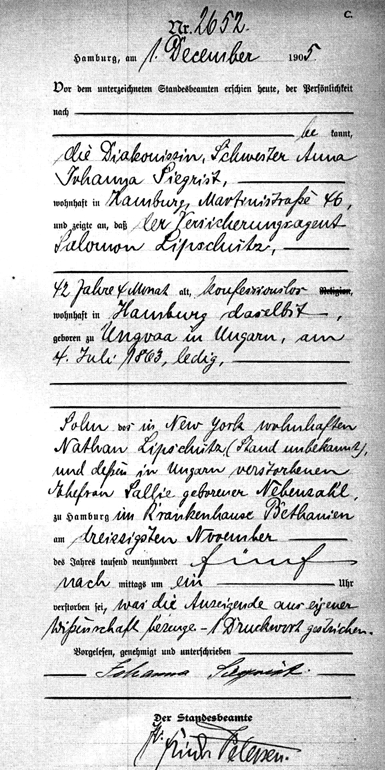
Below is the translation by Mr Stullich:
‘No. 2652
Hamburg, 1 December 1905
Before the undersigned registrar there appeared today, personally known, the deaconess, Sister Anna Johanna Siegrist, residing in Hamburg, at Martinistrasse 46, and reported that Salomon Lipschütz, insurance agent, 42 years and 4 months old, no religion, residing in Hamburg at the address mentioned, born in Ungvaa [sic] in Hungary, on 4 July 1863, unmarried, son of Nathan Lipschütz, residing in New York (profession unknown), and his wife Sallie Nebenzahl, deceased in Hungary, died in the Bethanien Hospital on 30 November in the year 1905 in the afternoon at one p.m, as she, the reporting person, reported from her own knowledge.
Read out, accepted and signed
Johanna Siegrist
The Registrar [signature].’
(7657)
Eduardo Bauzá Mercére (New York, NY, USA) has found the following on page 2 of the New York Daily Tribune, 3 November 1883:
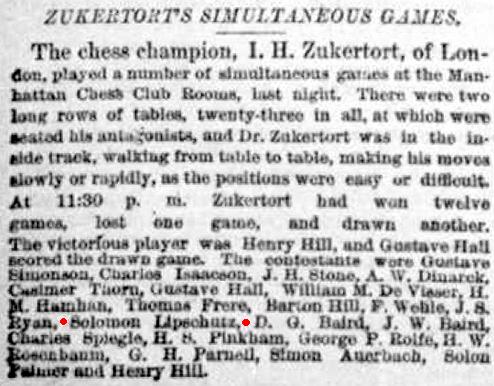
(7814)
John Blackstone (Las Vegas, NV, USA) points out further information about Lipschütz in the Brooklyn Daily Standard Union, 28 May 1892.
A newspaper item (New York Daily Tribune, 17 March 1889) pointed out by Jonathan Hinton (East Horsley, England) has references to Samuel Lipschütz.
Harry Golombek wrote as follows about Bogoljubow on page 76 of Chess Treasury of the Air by Terence Tiller (Harmondsworth, 1966):
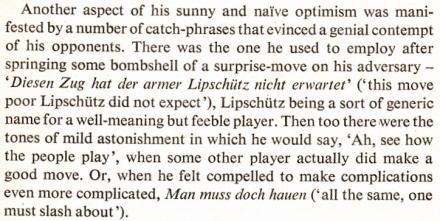
(8686)
Just received: Samuel Lipschütz A Life in Chess by Stephen Davies (Jefferson, 2015).
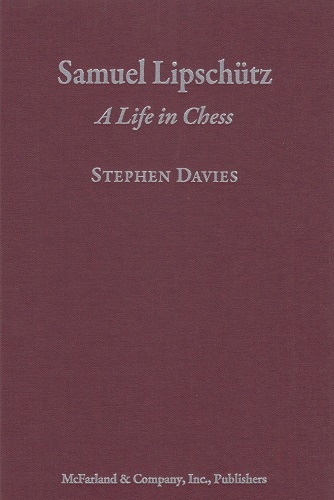
This book will enhance yet further the reputation of McFarland & Company, Inc. among chess bibliophiles.
(9336)
Lipschütz’s forename was discussed on pages 6-7, it being stated that no definitive answer can be given.
Peter Anderberg (Harmstorf, Germany) writes:
‘On page 361 of Samuel Lipschütz. A Life in Chess (Jefferson, 2015) Stephen Davies gives a consultation game by cable in April 1903 as “Lipschütz’s last published game of chess”.
However, at least one game played during his stay in Hamburg in 1904-05 has survived (a draw against Julius Dimer), thanks to Martin Bier and his column in the Hamburgischer Correspondent of 7 January 1905 (page 2 of the “Abend-Ausgabe, 2. Beilage”):’
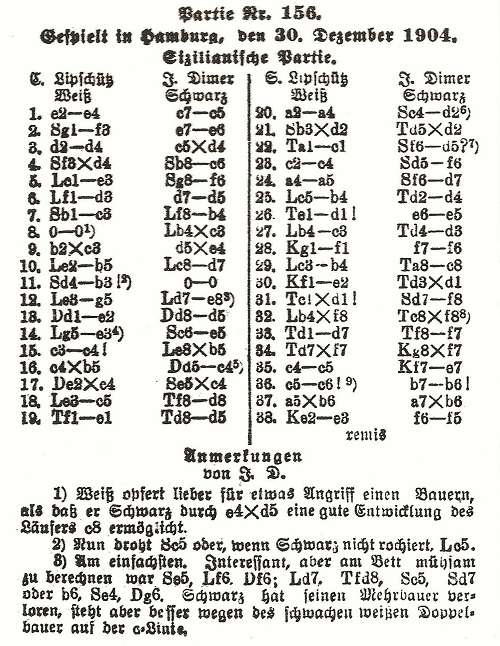
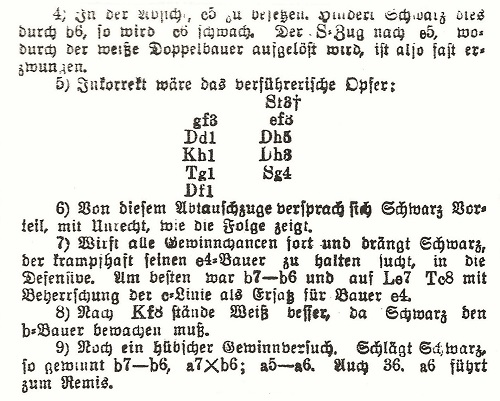
1 e4 c5 2 Nf3 e6 3 d4 cxd4 4 Nxd4 Nc6 5 Be3 Nf6 6 Bd3 d5 7 Nc3 Bb4 8 O-O Bxc3 9 bxc3 dxe4 10 Bb5 Bd7 11 Nb3 O-O 12 Bg5 Be8 13 Qe2 Qd5 14 Be3 Ne5
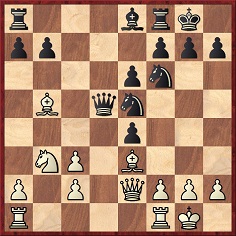
15 c4 Bxb5 16 cxb5 Qc4 17 Qxc4 Nxc4 18 Bc5 Rfd8 19 Rfe1 Rd5 20 a4 Nd2 21 Nxd2 Rxd2 22 Rac1 Nd5 23 c4 Nf6 24 a5 Nd7 25 Bb4 Rd4 26 Red1 e5 27 Bc3 Rd3 28 Kf1 f6 29 Bb4 Rc8 30 Ke2 Rxd1 31 Rxd1 Nf8 32 Bxf8 Rxf8 33 Rd7 Rf7 34 Rxf7 Kxf7 35 c5 Ke7 36 c6 b6 37 axb6 axb6 38 Ke3 f5 Drawn.
(10549)
From pages 179-181 of CHESS, February 1939:
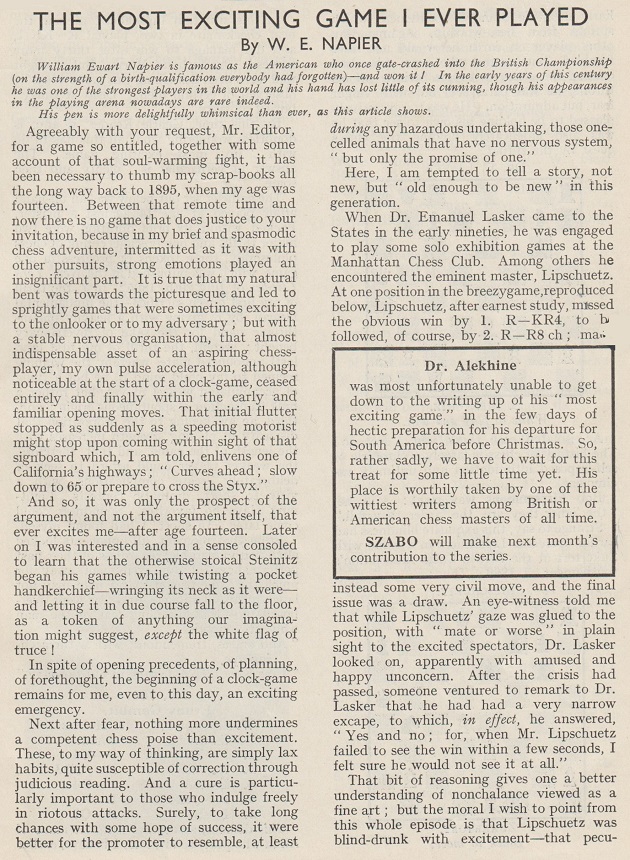
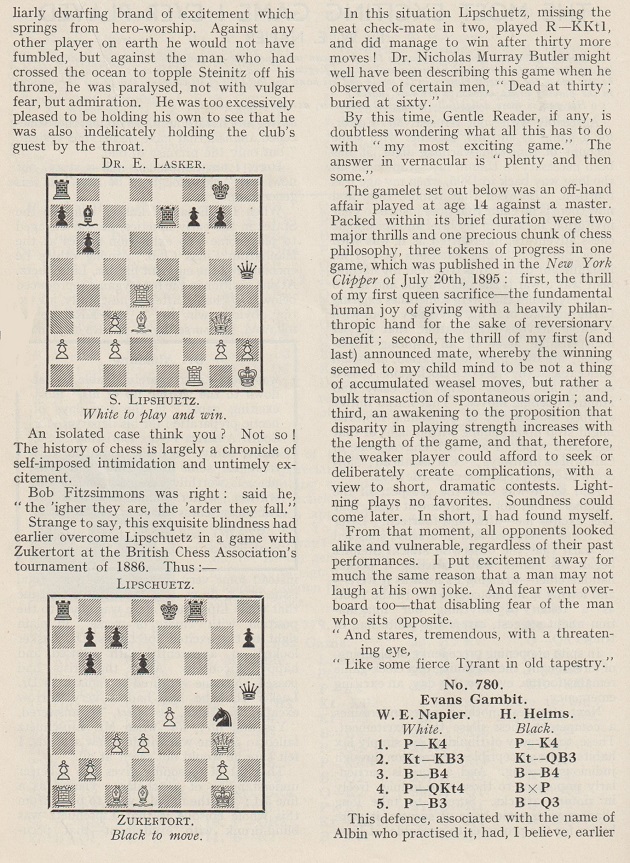
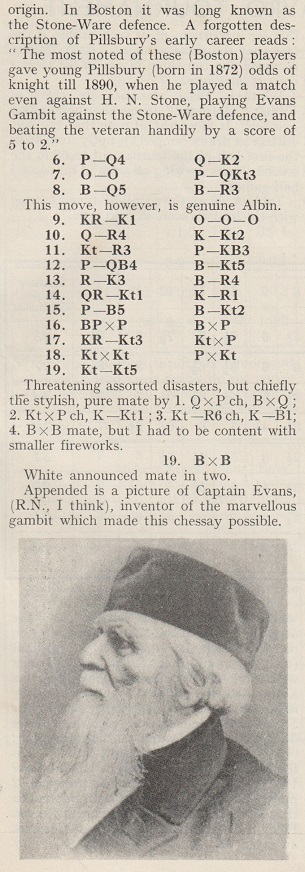
In the first diagram a black pawn is missing from c5. The remark by Napier in the ensuing paragraph is notable:
‘The history of chess is largely a chronicle of self-imposed intimidation and untimely excitement.’
It is also worth highlighting the CHESS Editor’s comment about Napier in the box on page 179: ‘one of the wittiest writers among British or American chess masters of all time.’
Napier’s article and the game against Helms were discussed on pages 13 and 339-341 of Napier The Forgotten Chessmaster by John S. Hilbert (Yorklyn, 1997). Helms wrote tributes to Napier on pages 86-87 of the September-October 1952 American Chess Bulletin and on page 70 of CHESS, Christmas 1952/January 1953.
(10690)
This photograph was published on page 129 of the August 1897 American Chess Magazine:

Larger version and detail of the front row
We see no caption in the American Chess Magazine, but as mentioned on page 408 of the first of two volumes on Pillsbury by Nick Pope (see the end of our article Harry Nelson Pillsbury), those seated nearest to the camera are Borsodi, Hanham, Pillsbury, Lipschütz, Pieczonka, Steinitz and Napier.
An Albert Pieczonka webpage shows another photograph from the same location.
Page 148 of the August 1897 American Chess Magazine has the group portrait given in C.N. 5550, and the following is on page 149:

The above images have been provided by the Cleveland Public Library.
(12030)
Addition on 3 November 2024:
Page 146 of the American Chess Magazine, October 1898:
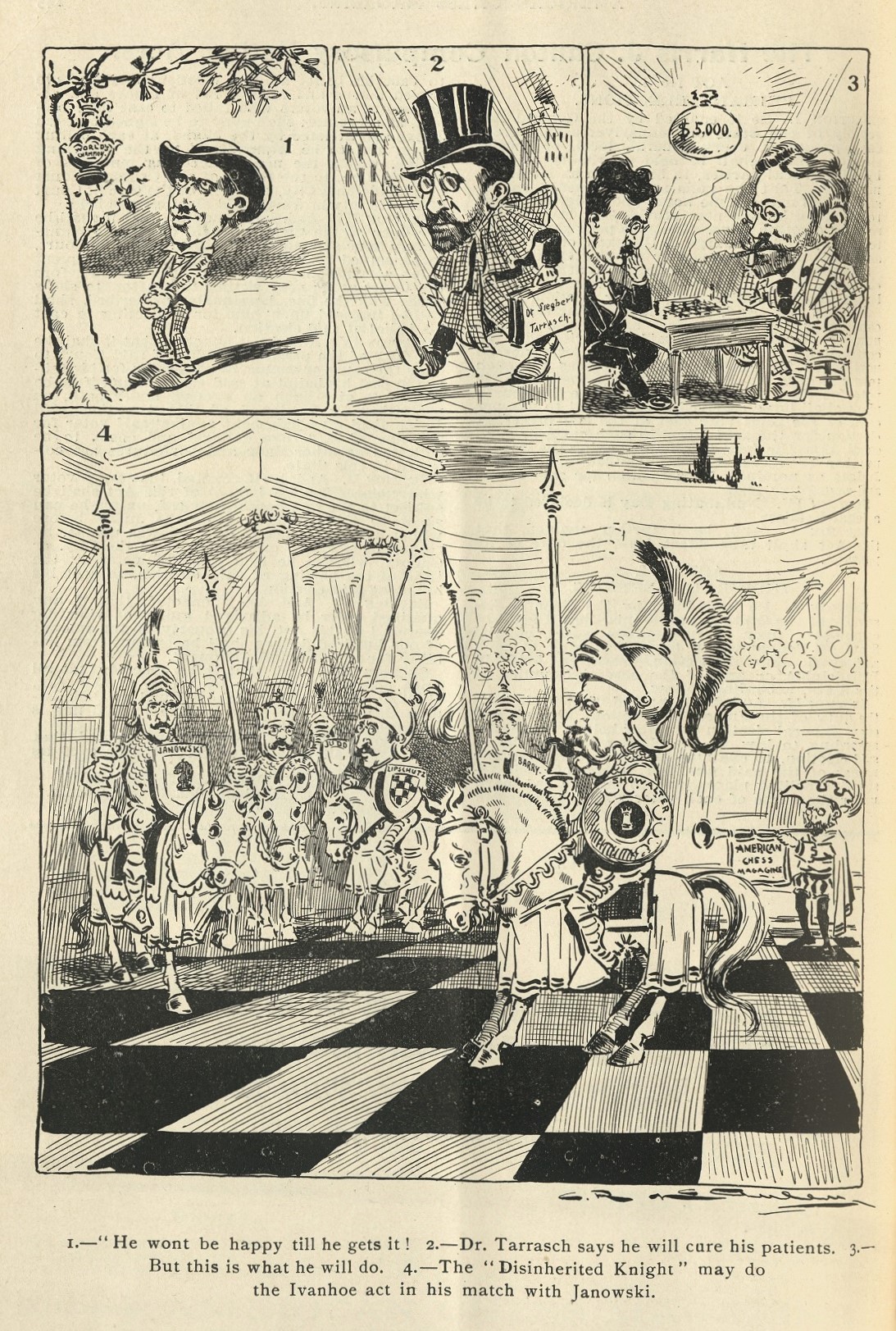
Acknowledgement for the scan: Cleveland Public Library
To the Chess Notes main page.
To the Archives for other feature articles.
Copyright: Edward Winter. All rights reserved.